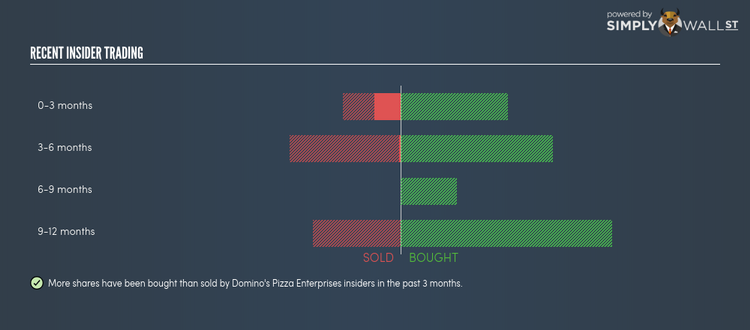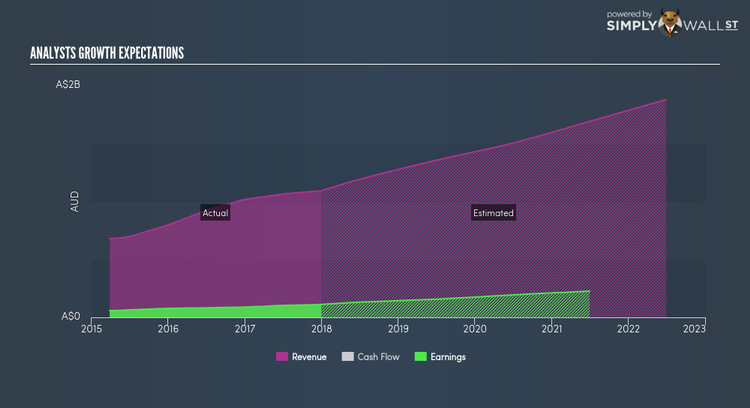Why Did Domino’s Pizza Enterprises Limited’s’ (ASX:DMP) Insiders Buy Up More Shares?

Domino’s Pizza Enterprises Limited operates retail food outlets. Domino’s Pizza Enterprises is one of Australia’s some insider buying over the past three months, with insiders investing in more than 2 million shares during this period. A well-known argument is that insiders investing more in their own companies’ shares sends an optimistic signal. A research published in The MIT Press (1998) concluded that stocks following insider buying outperformed the market by 4.5%. However, it may not be sufficient to base your investment decision merely on these signals. I’ve analysed two possible reasons driving the insiders’ decision to ramp up their investment of late.
View our latest analysis for Domino’s Pizza Enterprises
Who Are The Insiders?
There were more Domino’s Pizza Enterprises insiders that have bought shares than those that have sold. In total, individual insiders own over 6 million shares in the business, which makes up around 7.16% of total shares outstanding. .
The entity that bought on the open market in the last three months was
Colonial First State Asset Management (Australia) Limited Commonwealth Bank Officers Superannuation Corporation Pty Limited Pinnacle Investment Management Limited. Although this is an institutional investor, rather than a company executive or board member, the insights gained from direct access to management as a large investor would make it more well-informed than the average retail investor. In this specific instance, I would classify this investor as a company insider.
Is This Consistent With Future Growth?
At first glance, analysts’ earnings expectations of 74.96% over the next three years illustrates an optimistic outlook going forward which is consistent with the signal company insiders are sending with their net buying activity. Delving deeper into the line items,Domino’s Pizza Enterprises is believed to experience a strong double-digit revenue growth next year, which appears to flow through to an earnings growth of 29.74%. Improved cost management and sustained high revenue growth could lead to higher earnings growth in the future. Insiders’ conviction in this strong performance is illustrated by their ramp up in shareholdings. Or they may merely believe the stock is undervalued by the market relative to the growth potential it will deliver.
Did Stock Price Volatility Instigate Buying?
Alternatively, the timing of these insider transactions may have been driven by share price volatility. Volatility provides an opportunity to trade on market inefficiencies when the stock is under-priced compared to the stock’s intrinsic value. Domino’s Pizza Enterprises’s shares ranged between A$49.5 and A$38.98 over the past three months. This indicates moderate volatility with a share price movement of 26.99%. Insiders’ purchases may not be driven by this movement but perhaps their view of the company’s growth in the future or simply their individual portfolio rebalancing.
Next Steps:
Domino’s Pizza Enterprises’s insider meaningful buying activity tells us the shares are currently in favour, which is relatively consistent with expected earnings growth, even if the low share price volatility did not warrant exploiting any mispricing. Although insider buying can be a useful prompt, following the lead of an insider, however, will never replace diligent research. I’ve put together two relevant aspects you should further examine:
Financial Health: Does Domino’s Pizza Enterprises have a healthy balance sheet? Take a look at our free balance sheet analysis with six simple checks on key factors like leverage and risk.
Other High Quality Alternatives : Are there other high quality stocks you could be holding instead of Domino’s Pizza Enterprises? Explore our interactive list of high quality stocks to get an idea of what else is out there you may be missing!
NB: Figures in this article are calculated using data from the last twelve months, which refer to the 12-month period ending on the last date of the month the financial statement is dated. This may not be consistent with full year annual report figures.
To help readers see pass the short term volatility of the financial market, we aim to bring you a long-term focused research analysis purely driven by fundamental data. Note that our analysis does not factor in the latest price sensitive company announcements.
The author is an independent contributor and at the time of publication had no position in the stocks mentioned.


